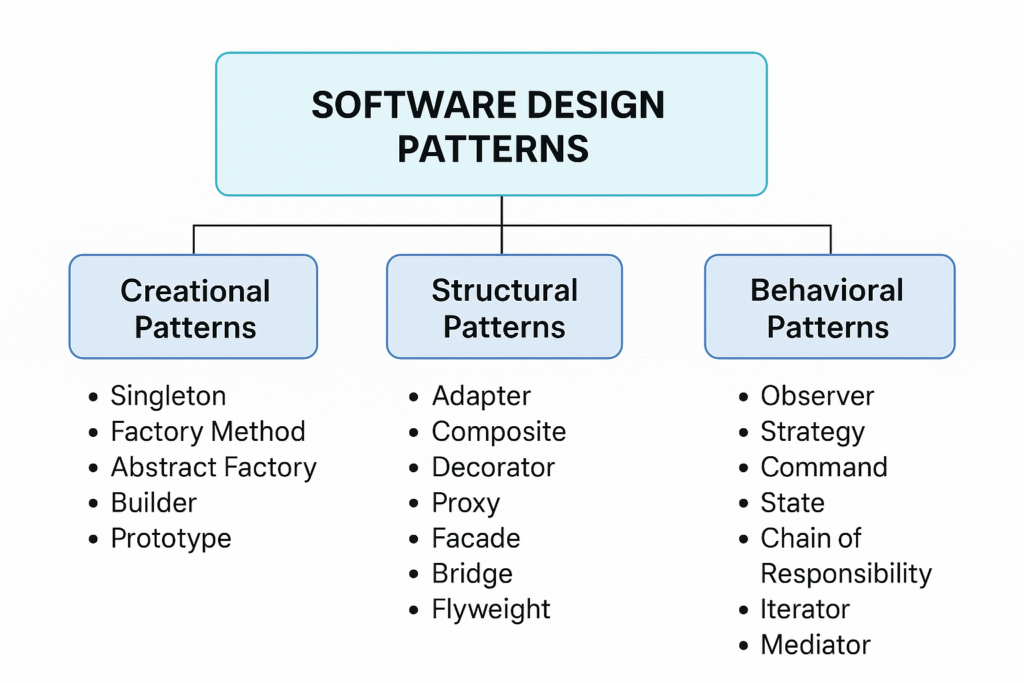If you’re a software developer aiming to write clean, scalable, and maintainable code, understanding design patterns is essential. These proven solutions to common software design problems help you write better code, improve team communication, and scale your applications with ease.
In this blog post, we’ll explore:
- What are Design Patterns?
- Benefits of Using Design Patterns
- The 3 Main Types of Design Patterns
- Commonly Used Design Patterns (with real-life examples)
- Best Practices for Using Design Patterns
Let’s dive in!
💡 What are Design Patterns?
Design patterns are typical solutions to commonly occurring problems in software design. They’re like blueprints you can customize to solve a particular design issue in your codebase.
They were popularized by the “Gang of Four” (GoF) in their influential book “Design Patterns: Elements of Reusable Object-Oriented Software.”
🚀 Benefits of Using Design Patterns
- Improve code readability and structure
- Promote reusability and modularity
- Simplify communication among developers
- Facilitate scalable and testable code
- Speed up the development process
🧱 Types of Design Patterns
Design patterns are generally divided into three main categories:

1. Creational Patterns – How objects are created.
Examples: Singleton, Factory Method, Abstract Factory, Builder, Prototype
2. Structural Patterns – How classes and objects are composed.
Examples: Adapter, Composite, Decorator, Proxy, Facade, Bridge, Flyweight
3. Behavioral Patterns – How objects interact and communicate.
Examples: Observer, Strategy, Command, State, Chain of Responsibility, Iterator, Mediator, Memento
🔧 Most Common Design Patterns (with Sample Examples)
1. Singleton Pattern (Creational Pattern)
Purpose: Ensures a class has only one instance.
Use Case: Database connection pool, configuration classes
public class Singleton {
private static Singleton instance;
private Singleton() {}
public static Singleton getInstance() {
if (instance == null) {
instance = new Singleton();
}
return instance;
}
}2. Factory Pattern (Creational Pattern)
Purpose: Provides an interface for creating objects in a superclass, but allows subclasses to alter the type of objects created.
Use Case: Creating different shapes, notifications, or UI components.
interface Shape {
void draw();
}
class Circle implements Shape {
public void draw() { System.out.println("Drawing Circle"); }
}
class ShapeFactory {
public Shape getShape(String type) {
if ("circle".equalsIgnoreCase(type)) return new Circle();
return null;
}
}3. Observer Pattern (Behavioral Pattern)
Purpose: One-to-many dependency where when one object changes state, all its dependents are notified.
Use Case: Event handling systems, pub-sub mechanisms
interface Observer {
void update(String message);
}
class EmailSubscriber implements Observer {
public void update(String message) {
System.out.println("Email Received: " + message);
}
}4. Strategy Pattern (Behavioral Pattern)
Purpose: Allows a class behavior to be selected at runtime.
Use Case: Payment systems (CreditCard vs UPI), sorting algorithms
interface PaymentStrategy {
void pay(int amount);
}
class CreditCardPayment implements PaymentStrategy {
public void pay(int amount) {
System.out.println("Paid " + amount + " via Credit Card");
}
}5. Decorator Pattern (Structural Pattern)
Purpose: Add behavior to objects dynamically without altering the class.
Use Case: Wrapping streams, UI components
interface Coffee {
String getDescription();
}
class BasicCoffee implements Coffee {
public String getDescription() {
return "Basic Coffee";
}
}
class MilkDecorator implements Coffee {
private Coffee coffee;
public MilkDecorator(Coffee coffee) {
this.coffee = coffee;
}
public String getDescription() {
return coffee.getDescription() + ", with milk";
}
}
6. Builder Pattern (Creational Pattern)
Use Case: When you want to build a complex object step-by-step.
class Pizza {
private String dough;
private String cheese;
private String topping;
public static class Builder {
private String dough;
private String cheese;
private String topping;
public Builder setDough(String dough) {
this.dough = dough;
return this;
}
public Builder setCheese(String cheese) {
this.cheese = cheese;
return this;
}
public Builder setTopping(String topping) {
this.topping = topping;
return this;
}
public Pizza build() {
Pizza pizza = new Pizza();
pizza.dough = this.dough;
pizza.cheese = this.cheese;
pizza.topping = this.topping;
return pizza;
}
}
}
7. Adapter Pattern
Use Case: Connect two incompatible interfaces.
interface MediaPlayer {
void play(String filename);
}
class VLCPlayer {
void playVLC(String filename) {
System.out.println("Playing VLC: " + filename);
}
}
class VLCAdapter implements MediaPlayer {
private VLCPlayer vlcPlayer = new VLCPlayer();
public void play(String filename) {
vlcPlayer.playVLC(filename);
}
}
8. Facade Pattern
Use Case: Provide a simplified interface to a complex system.
class CPU {
void start() { System.out.println("CPU started"); }
}
class Memory {
void load() { System.out.println("Memory loaded"); }
}
class ComputerFacade {
private CPU cpu = new CPU();
private Memory memory = new Memory();
void startComputer() {
cpu.start();
memory.load();
System.out.println("Computer started");
}
}
✨ Final Thoughts
Design patterns are time-tested solutions that make your code more elegant, maintainable, and extensible. Whether you’re working on a large enterprise system or a side project, having design patterns in your toolkit will make you a more effective developer.

